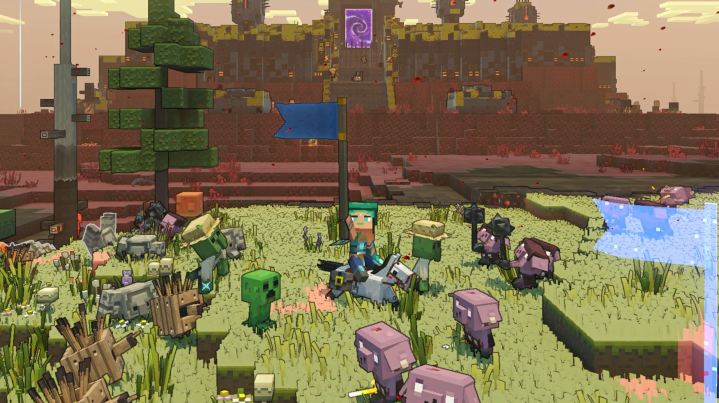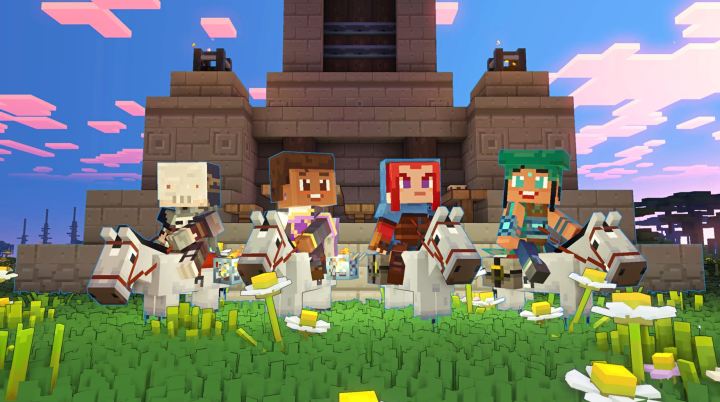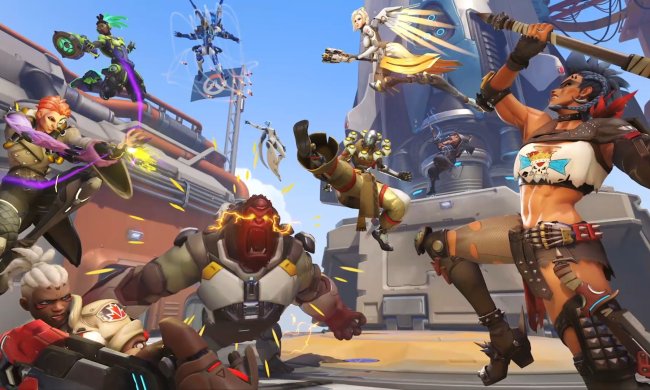“Minecraft Legends does a great job at making the real-time strategy genre more approachable, even if its campaign gets repetitive.”
- Great use of Minecraft
- Approachable RTS gameplay
- Moldable environments
- Strong multiplayer
- Gets repetitive fast
- Room for UX improvements
Real-time strategy games are a tricky genre for new players due to their complexity. And that makes it a perfect genre for Minecraft to tackle.
Minecraft made survival crafting games approachable and endearing to a generation of young players, while Minecraft Dungeons introduced players to an intense style of action game dominated by the very mature Diablo series. With Minecraft Legends, Mojang and Blackbird Interactive had a great opportunity to create an approachable, yet complex RTS experience that blends in key aesthetics and mechanics from Minecraft.
For the most part, it succeeds. Minecraft Legends is a rock-solid RTS game that melds the minion-commanding of Pikmin, the exploration and base-pillaging of Age of Empires, and the building of tower defense games. Still, that approachable design does come at a cost: Minecraft Legends gets repetitive very quickly. Those who enjoy some more variety in their RTS experiences might move on quickly if they aren’t interested in its enjoyable multiplayer mode.
A new frontier for Minecraft
Minecraft is intrinsically tied to the survival crafting game space, so it’s always novel to see how its spinoffs in different genres transform the basics while still retaining aesthetics and gameplay ideas that helped make Mojang’s game so iconic. As soon as I booted up Minecraft Legends and got into a campaign, I was transported to its unmistakable world. The opening cinematics highlight the Piglins’ invasion of the Overworld and how three “Hosts” named Foresight, Action, and Knowledge recruit a Minecraft player from a different dimension to come and save their world.
It’s like if Age of Empires played like Pikmin.
The story of Minecraft Legends isn’t much deeper than a generic save-the-world plot, but its cinematics are all well-made, can be pretty funny at times, and give a unique flair to this specific game. The more significant shift Minecraft Legends represents for the IP is in its genre. This real-time strategy game is split into two major parts: attacking Piglin Outposts and defending villages. Players can explore a procedurally generated open world to get resources; recruit Minecraft mobs like Golems, Skeletons, Creepers, and Zombies to fight with them; and attack massive Piglin bases to loosen their hold on the Overworld.
Each mob a player can obtain has different uses. Stone Golems and Zombies are useful melee attackers that can quickly take down structures, while Skeletons are good at picking off buildings and enemies from afar. All units can be commanded at once, but issuing orders to specific troops is the most effective way to take down foes and the structures standing between you and a peaceful overworld. For those familiar with RTS games, it’s like if Age of Empires played like Pikmin.

Minecraft Legends firmly falls into the action-strategy subset of RTS games alongside Pikmin in these moments, and like those games, it feels surprisingly intuitive to play on a controller. A simple, but thorough tutorial teaches players most of the basics, while a comprehensive How to Play reference guide is always accessible in the game’s menu. Due to its brand name, I could see Minecraft Legends being the first introduction to RTS games for many players, and it does an excellent job of onboarding players into a complicated genre.
Build-a-base
As players explore their unique Minecraft Legends overworld, they’ll need to collect resources with Allays at their disposal. Resources are all elements Minecraft players will be familiar with: wood, stone, iron, coal, gold, diamond, and lapis lazuli. Accruing resources is one thing RTS games and survival games both have in common, so it’s no surprise to see that intact here.
With a bit of tweaking, Minecraft Legends could be even smoother to control.
Players can then build several objects with these resources, including pillars that grant permanent upgrades, a Carpenter building that can heal damaged structures, and towers that can shoot at attacking enemies. Crafting these things is necessary, as every procedurally generated Overworld in Minecraft Legends is populated with Villages, and one of them will be assaulted by Piglins each night.
If the fountain at the center of the village is destroyed, the village is lost, and the player will have to fight later to take it back. That means players need to build proper defenses so villages stay protected without direct intervention. This all adds a tower defense-like element that’s novel the first time or two and gives players another way to leave their mark on its locations; it really feels like I’m impacting and transforming the world with each battle. My procedurally generated world felt more personal when I’d walk past the battle scars left near a Piglin base I’d previously taken down, or through a village I’d built defenses for.

Still, the user experience for all of this could be better. Players can set specific structures they build a lot to a hotbar they can always access. While using the hotbar is surprisingly intuitive on a controller, setting it up in menus is a bit more frustrating, as it does not display the name of the item you’re replacing, so you’ll have to judge it off a tiny voxelated icon. Meanwhile, removing structures is a finicky process. There’s no easy way to despawn units made outside of them dying, and the deconstruct button is the same button shortcut you use to command units forward.
With a bit of tweaking, Minecraft Legends could be even smoother to control, but thankfully, it’s still a straightforward RTS. Players who can make it through Minecraft Legends should have no problem going even deeper into the genre. In fact, that point might even come long before the end of the game, as all I’ve described here gets quite repetitive fast.
Repetitive to a fault
The RTS genre can be repetitive and formulaic in that players need to learn the best builds and uses for each unit, and then maximize their effectiveness with them. Still, the best RTS games find ways to keep battles interesting. The Pikmin series is at its best when each day feels fresh, with more obstacles to overcome or areas to explore. In Age of Empires’ case, there are more complex systems to grapple with, plus lots of campaigns and different factions that change up environments and playstyles.
At launch, Minecraft Legends’ RTS formula is more one-note despite the fact that every campaign takes place in a unique, procedurally generated world. Once I charted the relatively small open world, my single-player adventure felt the same: I would repeatedly siege similar-looking bases or defend similar-looking villages. Within a couple of hours, I saw almost every building and obstacle enemy bases had to offer. From there, I was only dealing with slightly different terrain and building placement with each base and village I encountered. After a certain point, every Piglin base I raided blended together.

On the default difficulty, villages should survive the night so long as there are enough Carpetners and walls near its fountain. This ubiquity does make Minecraft Legends approachable; once you’re past the game’s opening tutorials, you’ll know what to do for the rest of the game. But it doesn’t do much to surprise players or keep things super interesting outside of four boss Piglins that pop up toward the endgame.
Procedural generation is very fitting for creating a compelling survival sandbox experience, but this RTS could’ve benefitted from a more handcrafted touch. In particular, I see a lot of potential with its Lost Legends mode that offers bite-sized challenges, and I hope this gets expansions that add new biomes, enemies, and base obstacles.
Less repetitive with others
Minecraft Legends feels most unique in its multiplayer options (I tried out both its 3v3 and 4v4 modes during the review period). It feels like a micro-version of a campaign as players rush to acquire the resources to build objects that will allow them to protect their base like they would a village in the campaign. The most effective strategies are to get as many resources as possible early on and build a smaller base structure closer to your opponent’s with a Redstone launcher that can deal massive damage to the enemy fountain.
You can always do something useful in Minecraft Legends’ multiplayer.
That can still play out in a lot of different ways. Throughout my match, I saw the world evolve as walls, towers, Redstone launchers, and more popped up across the map, and resources were depleted. Walking around in the final moments of a match feels much different than exploring the vast wilderness at the start. This makes each match more visually unique, and that’s reflected in the gameplay as well.
In one match, I focused on the base building; in another, I was much more aggressive about attacking the enemy’s base as soon as possible. Whether you like building, combat, or just exploring and resource gathering, you can always do something useful in Minecraft Legends’ multiplayer. And if new structures and mobs come to the game over time, I can see this mode only getting better and better. Once players get a good grip on the game’s core mechanics in the campaign, there’s a good chance they’ll have a lot more fun in multiplayer.

That speaks to how Minecraft Legends is an entertaining RTS game at its core. It gets too repetitive for its own good in campaigns, and a few minor gameplay changes are needed to make swapping out structures easier, but this is an approachable RTS that can serve as a gateway to a tricky genre. With Pikmin 4 on the horizon for this July and Stormgate’s beta slated for later this year, 2023 is a great time to get into real-time strategy games. And despite its flaws, Minecraft Legends will likely be that entry point to RTS games for many young players.
Minecraft Legends was reviewed on Xbox Series X and S consoles.




